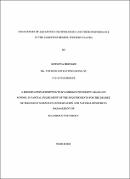| dc.description.abstract | Overfishing is a challenge that has caused the extinction of endemic fish species and decreasing
fish stocks in Lake Albert. This study focuses on the performance of aquaponics technology as a
farming alternative in Hoima region to address the challenges faced by aquaponics farmers. This
technology is known to provide fish resources and agricultural products for both commercial and
domestic consumption. The objectives of this study included; comparing the performance of fish,
small and large leaf plants in an aquaponics system, determining the efficiency of plant beds in
filtering water, and identifying the challenges faced by aquaponics farmers in Hoima district.
The methodology involved running experimental treatments at Kyambo~o University Biology
Department Aquaponics System (KYUBDAS) for 4 months between 29 March and July 20th
2019 to resonate with the preliminary study of the challenges faced by aquaponics farmers in
Hoima. The KYUBDAS investigation helped this study identify the performance of fish and
plants in a Recirculating fish Aquaculture System (RAS). The fish species were; (1) Nile tilapia
(Oreochromis niloticus) (2) African catfish (Clarius gariepinus) and vegetable plants included:
(l) Coriander (Coriandrum sativa) (2) Kale/ Sukuma wiki (Brassica o!eracea), (3) Spinach
(Spinacia oleracea), and ( 4) Lettuce (Lectuca saliva). Data collection methods and materials
involved use of the Hydrolab apparatus, taking records of fi sh mortality, and a foot ruler for
measuring midrib lengths and counting number of plant leaves. Due to differences in nutrient
demands, tests were run on samples of Sukuma wiiki (big leaf plants) and Coriander (small leaf
plants) for presence of Carbohydrates, proteins, and moisture nutrients. Hoima aquaponics
farmers were questioned and interviewed to obtain knowledge of challenges in aquaponics. Data
analysis was done using SPSS, Minitab17, and Students' T-tests for quantitative data analysis
and QGIS to generate maps for the data collected. The results for plant nutrient intake indicated
that plants (both planted in a hydroponic setting and in the soil) performed better with
aquaculture effluent compared to those using water (H20). The study found out that plants with
small and simple leaves like coriander and lettuce take a smaller number of days and effluent
content to obtain maximum fresh and dry matter compared to the big leaf plants. The fresh
weight, moisture and protein contents of plants with small leaves (C. saliva) and big leaves (B.
o!eracea) did not show any significant difference with p values, 0.077, 0.352 and 0. I 76
respectively. However, dry weight showed a significant difference (p = 0.0 l) between the two
plant varieties. The study revealed that Small leaf plant varieties can grow well in shallow media
beds compared to the big leaf plants like Sukuma wiiki and Spinach which may need
supplemental N.P.K if the N03 absorbed from the fish effluent is lacking sufficient nutrients.
Shallow (611-811
) and clogged media beds affect performance of big leaf plants as they grow. Over
80% of aquaponics farmers face water availability problems and poor record keeping deprives
their realization of over Ushs 37,000,000 for large scale and over Ushs 2,900,000 for small scale
farmers per year in aquaponics business. The study recommends the culture of Nile tilapia
( Oreochromis nilolicus) for aquaponics to supplement catfish (Clarius griepinus) in aquaponics
fanning. It is also recommended that major challenges in Hoima District aquaponics
management need Government and private sector participation to provide sensitization,
functional regional hatcheries and community involvement for sustainable fish resources yield. | en_US |

